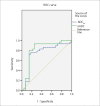MRI in the differential diagnosis of primary architectural distortion detected by mammography
- PMID: 26899149
- PMCID: PMC4790065
- DOI: 10.5152/dir.2016.15017
MRI in the differential diagnosis of primary architectural distortion detected by mammography
Abstract
Purpose: We aimed to evaluate the diagnostic accuracy of a combination of dynamic contrast-enhanced magnetic resonance imaging (DCE-MRI) and apparent diffusion coefficient (ADC) values in lesions that manifest with architectural distortion (AD) on mammography.
Methods: All full-field digital mammography (FFDM) images obtained between August 2010 and January 2013 were reviewed retrospectively, and 57 lesions showing AD were included in the study. Two independent radiologists reviewed all mammograms and MRI data and recorded lesion characteristics according to the BI-RADS lexicon. The gold standard was histopathologic results from biopsies or surgical excisions and results of the two-year follow-up. Receiver operating characteristic curve analysis was carried out to define the most effective threshold ADC value to differentiate malignant from benign breast lesions. We investigated the sensitivity and specificity of FFDM, DCE-MRI, FFDM+DCE-MRI, and DCE-MRI+ADC.
Results: Of the 57 lesions analyzed, 28 were malignant and 29 were benign. The most effective threshold for the normalized ADC (nADC) was 0.61 with 93.1% sensitivity and 75.0% specificity. The sensitivity and specificity of DCE-MRI combined with nADC was 92.9% and 79.3%, respectively. DCE-MRI combined with nADC showed the highest specificity and equal sensitivity compared with other modalities, independent of the presentation of calcification.
Conclusion: DCE-MRI combined with nADC values was more reliable than mammography in differentiating the nature of disease manifesting as primary AD on mammography.
Figures


Similar articles
-
The diagnostic value of MRI for architectural distortion categorized as BI-RADS category 3-4 by mammography.Gland Surg. 2020 Aug;9(4):1008-1018. doi: 10.21037/gs-20-505. Gland Surg. 2020. PMID: 32953609 Free PMC article.
-
Diagnostic performance of ADC for Non-mass-like breast lesions on MR imaging.Magn Reson Med Sci. 2010;9(4):217-25. doi: 10.2463/mrms.9.217. Magn Reson Med Sci. 2010. PMID: 21187691
-
The Role of Combined Diffusion-Weighted Imaging and Dynamic Contrast-Enhanced MRI for Differentiating Malignant From Benign Breast Lesions Presenting Washout Curve.Can Assoc Radiol J. 2021 Aug;72(3):460-469. doi: 10.1177/0846537120907098. Epub 2020 Mar 11. Can Assoc Radiol J. 2021. PMID: 32157892
-
Breast cancer surveillance.Minerva Ginecol. 2016 Oct;68(5):509-16. Epub 2016 Feb 29. Minerva Ginecol. 2016. PMID: 26924173 Review.
-
Evaluation of architectural distortion with contrast-enhanced mammography.Clin Radiol. 2024 Mar;79(3):163-169. doi: 10.1016/j.crad.2023.11.021. Epub 2023 Dec 10. Clin Radiol. 2024. PMID: 38114374 Review.
Cited by
-
Contrast-enhanced mammography in the management of breast architectural distortions and avoidance of unnecessary biopsies.Breast Cancer. 2024 Sep;31(5):851-857. doi: 10.1007/s12282-024-01599-x. Epub 2024 May 29. Breast Cancer. 2024. PMID: 38811515
-
Texture Analysis of DCE-MRI Intratumoral Subregions to Identify Benign and Malignant Breast Tumors.Front Oncol. 2021 Jul 8;11:688182. doi: 10.3389/fonc.2021.688182. eCollection 2021. Front Oncol. 2021. PMID: 34307153 Free PMC article.
-
Synthetic MRI, multiplexed sensitivity encoding, and BI-RADS for benign and malignant breast cancer discrimination.Front Oncol. 2023 Feb 3;12:1080580. doi: 10.3389/fonc.2022.1080580. eCollection 2022. Front Oncol. 2023. PMID: 36818669 Free PMC article.
-
Diagnostic Performance of Breast Magnetic Resonance Imaging in Non-Calcified Equivocal Breast Findings: Results from a Systematic Review and Meta-Analysis.PLoS One. 2016 Aug 2;11(8):e0160346. doi: 10.1371/journal.pone.0160346. eCollection 2016. PLoS One. 2016. PMID: 27482715 Free PMC article.
-
Diagnostic performance of breast tumor tissue selection in diffusion weighted imaging: A systematic review and meta-analysis.PLoS One. 2020 May 6;15(5):e0232856. doi: 10.1371/journal.pone.0232856. eCollection 2020. PLoS One. 2020. PMID: 32374781 Free PMC article.
References
-
- American College of Radiology. Illustrated breast imaging reporting and data system (BI-RADS): ultrasound. Reston, VA: American College of Radiology; 2003.
-
- Knutzen AM, Gisvold JJ. Likelihood of malignant disease for various categories of mammographically detected, nonpalpable breast lesions. Mayo Clin Proc. 1993;68:454–460. http://dx.doi.org/10.1016/S0025-6196(12)60194-3. - DOI - PubMed
-
- Shaheen R, Schimmelpenninck CA, Stoddart L, Raymond H, Slanetz PJ. Spectrum of diseases presenting as architectural distortion on mammography: multimodality radiologic imaging with pathologic correlation. Semin Ultrasound CT MR. 2011;32:351–362. http://dx.doi.org/10.1053/j.sult.2011.03.008. - DOI - PubMed
-
- Burrell HC, Sibbering DM, Wilson AR, et al. Screening interval breast cancers: mammographic features and prognosis factors. Radiology. 1996;199:811–817. http://dx.doi.org/10.1148/radiology.199.3.8638010. - DOI - PubMed
MeSH terms
Substances
LinkOut - more resources
Full Text Sources
Other Literature Sources
Medical

